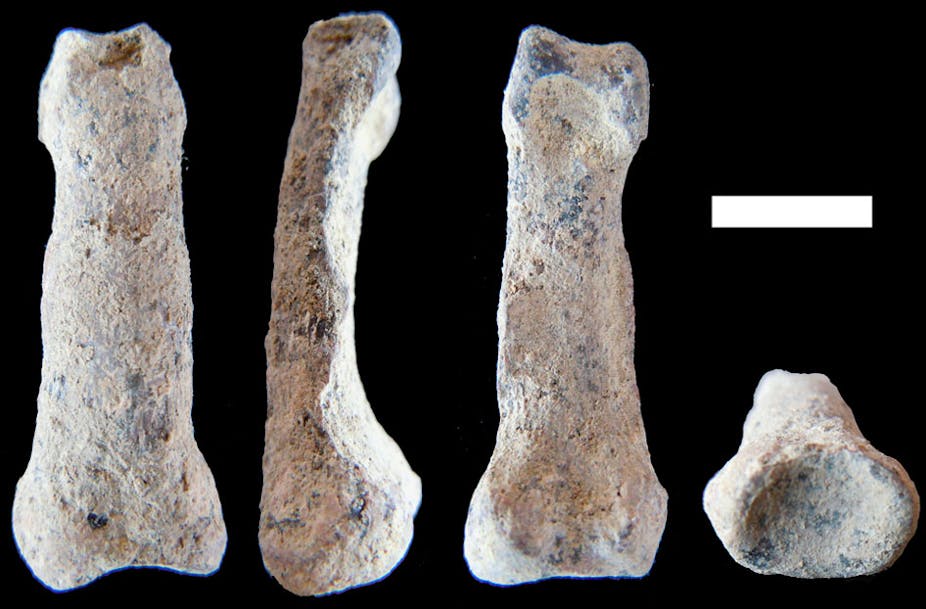It may not have quite have the same wow factor as a skull, but the discovery of a pinkie bone that is more than 1.8 million years old may help us solve the puzzle of stone-tool use among our early ancestors. The bone, which is the earliest modern human-like finger bone ever found, could come from a number of species that were around at the time, including Homo erectus.
The international research team that made the discovery spent hours patiently excavating under the punishing Tanzanian sun at the famous Olduvai Gorge site. And luckily, they didn’t come away empty-handed. The finger bone they found is remarkably similar to those of modern humans, suggesting the ancestry of the modern hand may be much older than we thought.
The hand that rocks the evolutionary cradle
Our fingers have three bones, known as phalanges; the tip, the middle, and the basal one that connects to the bones of the hand at the knuckle. It is this last one that has been recovered from sediments dated to more than 1.84 million years ago.

The new specimen comes from the little finger of the left hand – a stunning discovery given that these bones don’t preserve as well as skulls and the bigger, more robust bones of the body. For that reason it is hard to find these types of bones from this time period.
The researchers describe the bone as “modern human-like” because it is straighter than the bones of apes and early hominins who typically lived in trees and therefore had more curved finger bones. This is another reason why the bone is so exciting – modern humans as we define them did not appear on the scene for another 1.6 million years or more.
Meet the candidates
So which species were around at Olduvai at the time that could have had manual dexterity in the palm of its hand? Paranthropus boisei was a very robust ape-like creature, probably adapted to eating the toughest fruits and nuts. Although by no means certain, the evidence suggests this species may have lived at least some of the time in forested environments. Hand bones from Swartkrans in South Africa have been attributed to this species, and some palaeolanthropologists have argued they show the right kind of manipulative ability to make stone tools. But others disagree, so the jury is still out.
Homo habilis is another potential candidate for having lost its pinkie at Olduvai, but even with this species there are uncertainties. Research in recent years has shown that the skeleton of this species also point to it being adapted to living in trees. Its fingers are not a good match for the new discovery. Yet when first discovered and described it was thought that Homo habilis was the real maker of the Oldowan stone tool kit – its name actually means “handy man”.
The Homo habilis type specimen, which is the particular specimen against which all others are compared to confirm their identification, include a number of bones from the left hand. Researchers first analysing it in the 1960s thought of it as human-like partly because of its potential for a precision grip – essential for tool manufacture. But nowadays researchers are aware how long and curved its fingers are and see them as more comparable with apes.
However, the fact that Homo habilis did not have human-like fingers does not mean it couldn’t make tools, just like _P. boisei. _The earliest tools we have to date are 3.3 million years old – pre-dating the earliest examples we have of our own genus by perhaps as much as half a million years or more. Tool use is an adaptive strategy, and one that may have been experimented with by more species than just our own.

Homo rudolfensis is another species that may be contemporary with the new finger bone, and it is certainly contemporary with Homo habilis. However, while it is contemporary with Oldowan and Oldowan-like tools in Koobi Fora, Kenya, it has never before been discovered in Olduvai Gorge. There there really isn’t enough isn’t enough evidence to link the two.
Perhaps more promising is the final a candidate for the bone: Homo ergaster , as the earliest examples of Homo erectus are called. Some hand bones from Swartkrans in South Africa have suggested that it may have had the right kind of manipulative ability to make complex stone tools. But without any H. ergaster fossils from Olduvai from the same time as little finger, its still an open question.
The researchers, who have a justifiable reputation for scientific rigour, are not pointing the finger at one hominin or another – yet. However, I get the feeling they may just have a hunch about H. ergaster .

Not long after (in evolutionary terms) the time of little finger there was a major revolution in stone-tool making, including the invention of the handaxes of the Acheulean, which overtook the Oldowan as the main signature of stone tool production after 1.6 - 1.4 million years ago. The earliest dated Acheulean is about 1.75 million years ago from southern Ethiopia and from Lake Turkana in Kenya.
It would be exciting indeed if the team turn out to have identified early H. ergaster as the owner of the finger, perhaps just before they started making handaxes. Half a kilometre away from where the bone was found, and in the same clay bed, is the Oldowan site of FLK 22 Zinj, with abundant stone tools, none of them handaxes. Did the new tool type require a new kind of grip? Or, did forsaking a life in the trees inadvertently put new potential in the palm of their hands?
As the discoverers are at pains to note, until more fossils are discovered to clarify these questions, we can only guess. But until then let’s give the team a big hand, they deserve it.

